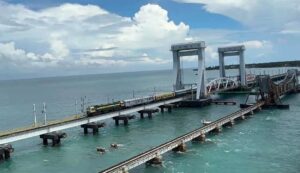To address CRS’s worries over the Pamban Bridge, the Railway Board forms a special committee
New Delhi: The Railway Board has formed a special committee to examine the concerns expressed by the Commissioner of Railway Safety (CRS) about the Pamban Bridge in an effort to guarantee the ongoing safety and dependability of one of India’s most recognizable rail facilities.

RK Goel, PED (Bridge), Railway Board, will serve as the chairman of the five-member technical committee. The Southern Railway Chief Bridge Engineer, the RVNL Director, the RDSO PED, and an impartial safety specialist will all be on the committee.
This action was taken in response to a report by the Commissioner of Railway Safety (CRS) that raised questions about the bridge’s safety standards and structural soundness. The bridge links the southern point of India to the rest of the nation.
The CRS pointed up a number of mistakes in the bridge’s design in its assessment. It made note of the lift span girder’s non-RDSO standard design and use of foreign codes, necessitating the RDSO’s participation in the project. Nevertheless, an examination of the documents revealed that RDSO had disregarded its obligation to design the girder with the Railway Board’s approval.
The CRS study also noted that a Technical Advisory Group (TAG) is usually established for significant bridge projects such as this one. However, in the case of the Pamban Bridge, this step was not taken since RDSO was decided to be excluded from the project.
According to the CRS assessment, there were major repercussions from RDSO’s separation from the project, including departures from accepted practices.
The Ministry of Railways responded by explaining that the Pamban Bridge is a 2.05-kilometer construction with a 72-meter vertical lift span that is unique to the nation. TYPSA, an international consultant, used both Indian and European norms to construct the bridge. IIT Chennai proof-checked the design. The Railway Board acknowledged technical shortcomings in the design assessment conducted by Railways and RDSO, considering that the bridge was created by a foreign consultant. Consequently, the Railway Board chose to have IIT, Mumbai, proof-check the design. Southern Railway accepted the design after a double-check.
The bridge was built using a design created by a reputable foreign consultant and rigorously verified by two of the nation’s top institutions.
IIT Madras and IIT Bombay have additionally verified and Southern Railway has accepted changes to the RDSO design for the approach girders to account for regional restrictions.
Furthermore, utilizing the most recent Phase Array Ultrasonic Testing, the Welding Research Institute in Trichy completed a 100% inspection of the structural components’ welding, which is essential to the bridge’s effectiveness. Southern Railway then carried out final test inspections.
The bridge uses polysiloxane paint with a 35-year design life, a unique painting technique employed in highly corrosion-prone regions around the globe, to prevent corrosion. Some of the innovative features used to prevent corrosion include FRP pathways, fully welded box sections in the lift span, the removal of splice joints in the approach span girders, stainless-steel reinforcement in reinforced concrete construction, and improved inspection arrangements and handrails.
The Ministry attested that cutting-edge design and best building procedures were used in the bridge’s construction. The Railway Safety Commissioner has given it the all-clear to begin operations.
The Ministry did, however, declare that it would completely comply with any more issues brought up by the CRS. To further improve the safety of the bridge, the five-member group has been charged with thoroughly assessing these issues and suggesting appropriate measures.





